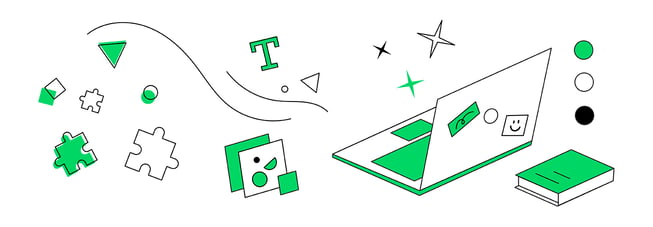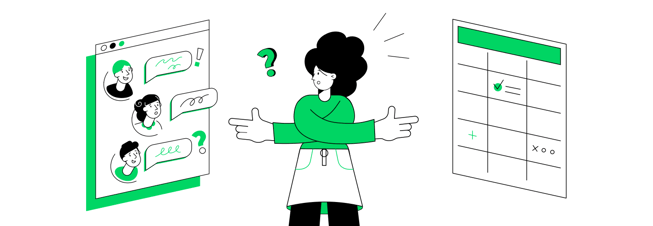18 UX Trends to Watch in 2021 (Updated)

State of UX in 2021
We put together a rundown of 10 current UX trends that will help you craft user-centered products in 2021 and beyond. These UX trends offer best practices for product design that will help provide a pleasurable experience for end users. Here's also an update for 2022 product design trends.
1. Meaningful conversations

Conversations with users will be getting much more personal this year. The language of interfaces augmented with machine learning algorithms will come closer to a real human voice and give the impression of being more individual. What's more, the role of the UX writer will gain importance.
Staying in touch with users will be a resource for embracing the newest interface trends. Leaning into animated illustrations, immersive graphics, augmented reality and strong storytelling are strong user interface trends that will create engaging products.
2. Voice assistants of the rise
Interaction with devices is going way beyond the screens of our smartphones. Voice User Interfaces (VUI) are becoming more present in our day-to-day life. The popularity of voice assistants shouldn’t be underestimated. They are already taking over new industries like hospitality or automotive. UX designers also need to start thinking beyond flat screens and learn to craft experiences using voice assistants so they’re relevant for the latest UX design trends.
3. More personalization
Try to think outside the design canvas. We no longer build with a one-size-fits-all mindset. Users expect unique experiences on every device, featuring personalized content made with their preferences and geographic, demographic, and psychographic data in mind.
Using machine learning algorithms you can collect more data about users to deliver an individual experience. Ultimately, it’s users who experience design. So whether it’s current design trends or longstanding practices, finding ways to think creatively for a better user experience is key.
4. Designers who code

Communication between designers and developers is essential to bringing a product to market. That’s why designers should get a better understanding of programming. The gap between designers and developers is becoming smaller and designers will also have to learn more about coding and start using more artificial intelligence solutions, thus creating a tech UI solution that can provide a pleasant experience.
5. Business-centered designs
Designers should know more about business. Enterprises value UX design agencies that offer UX experts with many years of experience and who are capable of taking responsibility for the products they deliver. That’s why designers should learn more about KPIs, market constraints, resources, and all the stakeholders’ needs to better shape the experience without losing real business value from their sight.
6. Crucial workflows
It’s no longer about selling a product. How the designers came up with the idea is more important than just creating the product itself. That’s why more and more designers will present their workflows, processes, and how they reached the final result as a part of the whole delivery package.
7. New design patterns

New, bigger-screen devices are designed with user comfort in mind. Thus we’ll see the rise of new design patterns with focus on gestures and bottom navigation controls. If foldable screens succeed, 2021 and the years beyond will be the time for designers to explore the new possibilities provided by this advancement and provide well-designed options for their customers.
8. Self-explanatory animations
Designs will be getting more self-explanatory thanks to leveraging animations. They can make a big difference in showing users how they can move around the application. Oftentimes, animated illustrations can better explain how to use the app than a block of text. On top of that, they’re way more appealing.
9. Security as a priority
We will be designing each product with security and privacy as a priority. Information about hacks and data breaches will continue to raise users' awareness of threats to their digital identity. One of the key future trends in UX research, biometrics give your user greater security and quicker access to the key components of the application.
Security is one of those areas that isn’t just a recent market trend — a security-based information architecture builds trust in your brand and is now a standard expectation among users of all skill levels.
10. AR, VR, and blockchain gaining momentum

Augmented or Virtual Reality and blockchain have already disrupted some industries, but we will see a bigger evolution of these technologies in 2021 and beyond. AR, VR, and blockchain will receive more attention and gain momentum in many applications.
11. Continuous change in the design world
So, what are the upcoming UX trends? If one thing is constant in the world of UX design, it’s change. Advances in UX technology provide a constant source of new tools, trends, and techniques, along with a deeper understanding of users’ needs and preferences.
Designers can be more productive, efficient, and precise than ever before, yet the end goal remains the same—to engage users with a seamless and pleasant experience. UX best practices are continually evolving — responding to this change is a constant to be prepared for.
12. Pushing the boundaries with motion design
Advances in browser capabilities have paved the way for motion design to become an integral part of UX design trends. Animations now bring digital interfaces to life, enhancing the brand message as well as helping users to understand what is happening on the screen.
Savvy designers will be pushing the boundaries with animation—from clever logos that add to a brand’s story to creative and entertaining page loaders. Motion is being used to convey information in new and exciting ways, engaging customers and enhancing their experience. A modern interface that embraces motion will also ensure fidelity to mobile design trends where users also expect to have rich experiences and powerful tools.
13. Focus on UX writing
 With brands looking to refine user experience as a way of standing out from the competition, copy is taking on unprecedented importance. Presenting users with the right message and using natural, easy-to-understand language makes them feel relaxed and safe and allows them to feel more connected to the product.
With brands looking to refine user experience as a way of standing out from the competition, copy is taking on unprecedented importance. Presenting users with the right message and using natural, easy-to-understand language makes them feel relaxed and safe and allows them to feel more connected to the product.
Copy should be clear and concise, with a focus on helping the user achieve their goal, rather than being overly creative, filled with jargon, or written for search engines. A modern app’s UX is complemented by clean writing that gives clear directions to the user, providing high value even if the application doesn’t always adhere to the latest designs trends.
14. Importance of context
Designers should be aware of the hidden factors that influence whether or not a product is used as intended. The consideration of what users might be doing at the time of using an app or checking a website will be crucial in making the right UX design choices.
For example, a user who is at work or in a rush will interact with a product very differently to someone who is at home and relaxed. We need to understand the world from our user’s perspective and adjust the product to suit the context of their situation.
Just think about it - social networks offer an illustration of how a product can fit into different situations. When it comes to UX trends, Instagram set one with Stories, as a simple video filling the screen and transitioning to the next became an immersive experience.
15. Interactive prototypes
While low-fidelity prototypes have their place, and are a great way to progress a design idea quickly, there is no substitute for testing user experience with interactive prototypes. Designs should always be tested and validated across a range of devices. Checking how the product feels on mobile, tablet, desktop, and any other device that may be used will reveal issues while there’s still time to make changes and will save you considerable time and money.
16. Multichanneling

With the boom in demand for connected devices such as Amazon’s Alexa and smart watches, businesses should be seizing the opportunity to tailor their products and conquer new markets. Successful brands will be shifting their mindset to focus on the user journey as a whole, rather than designing for each device in isolation.
This device-agnostic approach provides users with a seamless experience as they pass through a variety of touchpoints—from tablets to smart phones to smart home appliances. Considering how to build products for this multichannel world will be a hallmark of good design for the foreseeable future.
17. Inclusive design practices
Among the many critical current design trends is inclusive design. As far as user experience best practices go, inclusive design is ideal for building a solution that everyone is likely to enjoy.
Tap into a range of perspectives from your team to create interface design that does more than follow the latest design trends and instead removes barriers to getting the most from your solution. Designing for inclusion should be a standard part of your development practice.
18. Understanding development
The rise of no-code resources like Webflow has opened the doors for more creative professionals. Success will require gaining an understanding of how to create a modern UI, the latest trends in UX, and other key elements of building quality digital products. Even without code as a barrier, learning user experience best practices and staying on top of latest trends will be essential for success.
That's it for today. Hope our research into trends for 2021 will come useful in the UX design process. If you want to add something to our list leave us a comment or drop a message.







